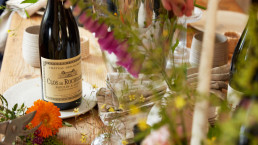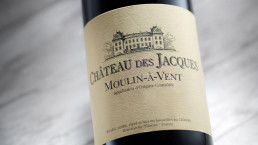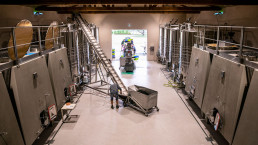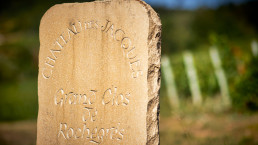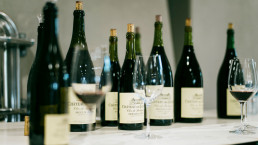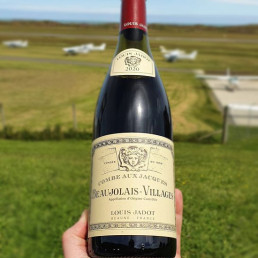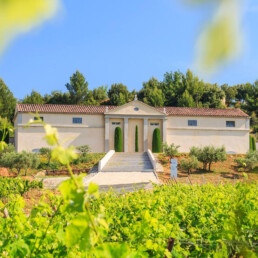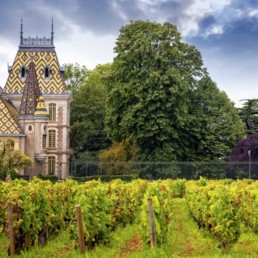Focus On: Beaujolais and NEW Chateau des Jacques
The Fun Red. A Wine and a Region Without Attitude!
“I drink Beaujolais every week … and just love the authenticity of the wines and the fantastic value.” – James Suckling, Wine Critic
Every now and again you can get “wined out”. A bit of palate fatigue or maybe you’re just bored with yet another Pinot, Syrah or whatever. Not one specific wine is getting you excited. Get ready for the antidote: a bottle or two of grapey, unpretentious, but decidedly well-crafted, Beaujolais! No, we’re not talking about the often-disparaged Beaujolais Nouveau, but rather some seriously sexy Beaujolais-Villages and Beaujolais Crus.
No wine region is more exciting right now than Beaujolais. The ‘Revolution’ unleashed by Jules Chauvet and his acolytes has spread far and wide. And no other region has produced a more dynamic crop of young natural wine producers than Beaujolais. That said, Beaujolais’ thrills don’t end with natural wine. The region is on the forefront of many of the most exciting trends in wine.
As always, Dhall & Nash is at the forefront of a bona fide wine trend, and is proud as Xmas punch to announce the arrival of prestigious Beaujolais estate, Chateau des Jacques, into our portfolio.
Trending Beaujolais:
The time has long come for Beaujolais to step away from being the black sheep of Burgundy. Beaujolais the region was too often lumped into part of southern Burgundy. Actually though, Beaujolais doesn’t have a whole lot in common with the rest of the that region in terms of climate, soil types and grape varieties. Beaujolais achieves its own unique identity with variations on style of one glorious grape in particular, Gamay Noir.
It is here from which Gamay can make a wine with class. Gamay hasn’t had an easy run of it — it’s always been compared to its pretty, smart, and complex sister, Pinot Noir. It really couldn’t get more humiliating for this poor grape — it’s the only one that has been publicly slandered! Believe it or not, it was banned from Burgundy in 1395, said to be bad for human health, when Philip the Bold, the Duke of Burgundy banished it south, making room for Pinot Noir to inhabit all of the “superior” hillsides of Burgundy proper. This turned out to be good news for Gamay as it produces a much better wine in the granitic soils of Beaujolais, compared with the limestone escarpments of the Côte d’Or.
Don’t mistake this region for a one-trick pony though. There’s a lot of complexity and diversity coming out of this humble grape. An hour north of the city of Lyon, Beaujolais’ spirit is half in the north of France, looking toward Burgundy, and half in the south, with eyes toward the Rhône Valley and Languedoc. Interestingly, that dichotomy is reflected in the region’s wines.
In the north, there are the age worthy, always fascinating wines made in the Burgundian fashion and sold under the 10 village appellations of the Beaujolais crus. In the south, there are easy-drinking wines sold under the Beaujolais and Beaujolais-Villages appellations.
How Cool Are These Beaujolais Wines?
Four styles of Beaujolais wines exist. The simplest, and one that has regrettably given the region a shoddy reputation, is Beaujolais Nouveau. This is the Beaujolais wine that is made using carbonic maceration (we’ll geek-explain this later) and is released on the third Thursday of November in the same year as its harvest. Originally it was a simple drink to celebrate the end of harvest. That idea grew to become a global marketing success peaking in the 80’s. But one thing to be remembered, is that it’s meant to be drunk young, and it’s meant to be flirty, fruity, and fun!
The rest of Beaujolais is where the serious wines are found. Aside from the wines simply labelled, Beaujolais, there are the Beaujolais-Villages wines, which must come from the hilly northern part of the region and offer reasonable values with some gems among them. The superior sections are the Cru vineyards coming from ten distinct communes. Any Cru Beaujolais will have its commune name clearly written on the label.
“The best wines of Beaujolais can easily rival Burgundies that cost many times more.” – JancisRobinson.com
How Did It Become So Hip?
Beaujolais has become a fertile ground for fascinating producers making deliciously different wines.
Ask any sommelier which wines they’re kicking back with off the clock and it’s a safe bet that Cru Beaujolais is on that list. Beaujolais has been one of the firm favourites with D&N staff for a good while. Here’s why: It’s delicious! It’s versatile! It’s interesting! It’s great value! And it has a cool back story!
Originally, its hipster vibe grew around Jules Chauvet, a négociant, oenologist and chemist from Beaujolais widely considered to be the godfather of natural wine, who influenced the pioneers of the modern natural wine movement, names like, Marcel Lapierre, Jean Foillard, Guy Breton, and Charly Thevenet. Together they have created the springboard for ongoing successful experimentation. Back in the 60’s and 70’s they pushed back on the accepted practices, took risks, and made amazing wines that found a worldwide audience. Now more than ever Beaujolais keeps leading the way as natural wine is no longer niche.
There have been many relatively recent arrivals to the region who have built on what came before without being beholden to it. They are not attached to any natural wine dogma, but they do have the same spirit as the earlier generation and follow the same path that lay at the movement’s roots, that is, the attention to detail in the vines and winery, the veneration of terroir, the attempt to rely as much as possible on healthy fruit and as little as possible on industrial techniques that make for ‘homogenous’ wine. They push and experiment and take risks, all with the aim of making great wines that reflect their piece of earth. And the wine world is richer for it.
Some of the Big Boys From Burgundy Are Newcomers to Beaujolais:
A bit of Burgundian money has drifted south into Beaujolais. Realistically, it would be hard to expect to find a ton of experimentation in the world’s most expensive wine real estate. When it purchased 200-acre Château des Jacques in 1996, négociant Louis Jadot became, the earliest arrival from Burgundy. Ownership of the company was attracted by the possibilities of the Gamay grape and the comparatively inexpensive land. It is now widely recognized as the most prestigious estates in Beaujolais.
Over the intervening years, Château des Jacques’ practices have been attributed with revolutionizing the winemaking of Beaujolais. They have notably raised the bar, applying Burgundian methods of winemaking that were once traditional in the region. These include long macerations of one month, with pump-overs, to extract colour, aroma, and tannins from the fruit, as opposed to the regional norm of 10- to 12-day macerations. Wild yeasts are used for fermentation, and this is extended longer than is typical in Beaujolais. Aging in oak barrels was also unusual for the area; Château des Jacques’ wines are barrel aged for 10 months to lend complexity to the wines. They are not wines to guzzle like ‘Bo-jo’ at a party; they are sophisticated expressions, deep and built to last.
“Gamay has to be excellent, otherwise it’s nothing,” says Beaujolais vigneron Dominique Piron. “Depending upon the soil, it’s a fabulous variety that is capable of expressing fruit, elegance and structure, as it is a genuine photocopy of the sub-soil.”
Let's Talk Beaujolais Rocks:
One thing that makes Beaujolais totally unique is its soils, based mainly on pink granite, a crystalline bedrock that was formed 350 million years ago. But it’s not that clear cut. Although the Beaujolais wine region is not very extensive geographically speaking, it encompasses a multitude of different soils in a highly surprising way; over 300 variants have been identified and described.
All these soil variations are a significant factor in defining the character of the region’s various wines. In the southern part of the region, south of the town of Villefranche, generally the soils are sandstone or clay and limestone. In the north, the soils are predominantly granite or schist on the upper slopes, with stone or clay on the lower slopes. And just as these soils are different in the north, so are the wines. The sturdiest, firmest Beaujolais wines come from northern vineyard sites, while the lightest, more supple wines come from the southern vineyards.
The region encompasses nearly 50,000 acres of vineyards. Most are situated in the eastern part of the region on undulating hills. Beaujolais is near enough to the Mediterranean Sea to experience the classic warm and dry weather characteristic of the Med. But it is also interior enough to experience cold dry weather from the Northeast. Overall, the climate is temperate.
Then there are the vineyards. The traditional way to plant vines was as bush vines, with each plant in its own universe. It’s hard to manage and harvest, but many vintners like this speak to the reverence of the unique heritage of old vines in Beaujolais. In more modern vineyards, younger vines are planted in rows, trained on wires, easy to control and harvest. Across all of Beaujolais, even the new plantings, must be harvested by hand.
All those factors come together in the wines. One thing that can be said with certainty:
“Beaujolais may have just one predominant grape—red Gamay, here since the 14th century—but it’s not one vast, homogenous vineyard. It has many styles; and producers have many tools in their backpacks.” – Wine Enthusiast
The Unique Beaujolais Winemaking Style:
A particular winemaking technique that’s widely practised in the region contributes significantly to the style of Beaujolais wines. That technique is called carbonic maceration. According to Cyril Chirouze, of Château des Jacques, destalking and long macerations were once the norm in Beaujolais, just as they are in Burgundy.
He explains that carbonic maceration, and its adaptation to semi carbonic maceration, are interlopers from Languedoc. There, the technique was used to make quick, inexpensive wine from Carignan and Aramon grapes for field and factory workers. “It was the creation of Beaujolais Nouveau in the 1950s, which needed to be made and drunk in months,” says Chirouze, that caused semi carbonic maceration to gain its tank-hold in Beaujolais.
Wine Geek Talk – What the Heck is Carbonic & Semi Carbonic Maceration?
The wine world is full of terms that people use without quite understanding just what they mean by them. And carbonic maceration is one of those terms that will get you labelled a geek more swiftly than saying “polyphenols”.
Carbonic maceration (CM) can completely change a wine’s style and flavour profile. Think about a red wine with bright ultra-fruity bubble-gum aromas or crunchy stemmy, vanilla, cinnamon, and earthy flavours. It’s likely you’ve encountered some level of carbonic maceration.
Without becoming too technical and boring it isn’t entirely black and white as pure carbonic maceration is quite rare. Let’s start with ‘normal’ fermentations.
Okay, so we know that most wine transforms from grape juice into alcohol via a yeast fermentation. Bunches of grapes are picked, destemmed, and crushed. The yeast, whether naturally present on the grape skins or added by winemakers, “eat” the natural sugars in the grape juice and converts them into alcohol.
In carbonic maceration, however, the initial fermentation is not caused by yeast, but instead occurs intracellularly, or from the inside out (anaerobic). This method involves filling a sealed vessel with carbon dioxide and then adding whole, intact bunches of grapes.
In this oxygen-free environment, the berries use the available CO2 to break down sugars and harsh malic acid (one of the main acids in grapes) and produces alcohol along with a range of compounds that affect the wine’s final flavour.
At the same time, polyphenols, known to most as tannins and anthocyanins, make their way from the grapes’ skin to the pulp, which turn the white flesh to a pink colour. Once the alcohol reaches 2%, the berries burst, releasing their juice naturally. A normal yeast fermentation will then finish the job. E voilà!
Now the more widely used semi carbonic maceration goes a bit like this: In Beaujolais for example, the entire clusters are transported in 50 litre bins and dumped in wooden cuvees, or cement or steel tanks. Some of the berries on the bottom are crushed by the weight of those above them, they start fermenting, and the tank fills up with carbon dioxide. These intact berries begin internal fermentation and then when they die, they release their juice, which still has quite a bit of sugar in it, keeping the fermentation process going. The higher pH that results from the intracellular degradation of malic acid means that malolactic fermentation can begin more easily after alcoholic fermentation finishes.
Plainly put, semi carbonic maceration occurs naturally in any vessel where oxygen is limited, carbon dioxide is rich, and a percentage of berries are intact. The science is as ancient as winemaking itself.
While semi-carbonic may be synonymous with Beaujolais, some local winemakers argue that the technique is a post-industrial invention which expresses little of a wine’s unique terroirs. Therefore, a growing number of producers have returned to traditional techniques. In other words, they’re making Gamay like its Pinot Noir neighbour in the north, solely through a yeast fermentation.
Believe or Not – 'Uncomplicated' Beaujolais Classifications:
Unlike the rest of French wine regions, here relative simplicity reigns. The wines of Beaujolais are divided into three Classifications: Beaujolais, Beaujolais-Villages, and Beaujolais Crus. (Beaujolais Noveau is a style not an A.O.C).
Not all Beaujolais is created equal. As we’ve read here, soil differences throughout the region and subtle variations in winemaking techniques cause the wines to vary considerably in style – from light bodied, precocious wines at one end of the spectrum to denser fuller-bodied wines at the other end.
Beaujolais Nouveau
Some wine geeks like to deride ‘Bo-jo Nu-vo’, criticising it for NOT being a serious wine. Actually, they’re right! It’s not meant to be a serious wine. Since when do all wines have to be serious anyway? But it is definitely the juicy frivo-luscious drink we want just because sometimes that’s what the palate or the occasion demands. Bo-Jo is a party animal!
Beaujolais & Beaujolais-Villages
Beaujolais ranks its vineyard sites. Ordinary vineyards can produce simple “Beaujolais”, while vineyards in higher-ranked villages can label their wines “Beaujolais-Villages”. Those wines tend to offer more than the basic Beaujolais: more complex flavours, more structure. For a French wine region this next category is strangely quite straightforward and clear – all the vineyards in the 10 Beaujolais Crus can label their wines with the Cru name only (so, “Morgon,” “Fleurie”, etc rather than “Beaujolais”). These wines represent the best of the Beaujolais: serious, charming, and often age-worthy wines.
Cru Beaujolais
The 10 Crus, from north to south are St-Amour, Juliénas, Chénas, Moulin-à-Vent, Fleurie, Chiroubles, Morgon, Régnié, Brouilly, and Côte de Brouilly. Each one has its own personality, its own character.
Moulin-à-vent – This is considered the sturdiest, most tannic, longest-lived among the 10 Crus of Beaujolais. When you hear about folks opening up delicious bottles of 50-year-old Beaujolais, it’s usually Moulin-à-Vent. But remember, we are still talking about Gamay. The wine is never that tannic, and most examples are still very approachable when they’re young, unless the vintage is a particularly structured one.
Morgon – Of the 10 crus of Beaujolais, this is the closest to Moulin-à-Vent in terms of weight and structure, and it can age nearly as well. It has a firm minerality, thanks chiefly to its granitic soils, and a fruit profile that shades towards orange.
Fleurie – has particularly fine terroir. “Fleur” of course, means “flower” in French, and indeed the wines of Fleurie are characterized by distinct floral note – think violet and rose. While Fleurie may not have the power of the well-known crus of Moulin-à-Vent and Morgon, its charming, floral elegance makes just as much of a lasting impression.
Juliénas – is another Cru known to be a little sturdier than the others and so can be aged. The wine’s signature profile is deep red cherries, which transform with a few years of bottle age into nuanced flavours that veer towards cassis.
Côte de Brouilly and Brouilly – As the word “Côte” implies, the Côte de Brouilly lies on the side of a hill. Its neighbour, Brouilly (without the “Côte”), is at the bottom. Predictably, Côte de Brouilly tends to ripen better, and it produces a more structured, elegant wine. Brouilly, meanwhile, produces a lighter style Beaujolais for early drinking; it makes frequent appearances in the simpler bistros that dot Paris.
St. Amour – is the most northerly of the 10 Crus of Beaujolais, bordering the Mâcon region of Burgundy. At its best, St. Amour is an intensely red-fruited wine, bearing a bit of a resemblance to its much more expensive cousin to the north in Burgundy’s Chambolle Musisgny, Les Amoureuses.
Chiroubles – position within the 10 Crus of Beaujolais is unique, as it is at the very highest altitudes of Beaujolais and the grapes take about a week longer to ripen than elsewhere. Chiroubles tend to have quite a bit of complexity, even as young wines, which makes the appellation a great source for Cru Beaujolais to drink young. This complexity derives from a lovely velvetiness that is absent in the other Crus, as well as a floral note that is reminiscent of Fleurie.
Régnié – in the vineyard, is distinguished by its pink granite soils. In the mouth, it seems to have a slightly spicier profile than the other Crus. It’s a lovely wine in the right hands, but unfortunately there are not many famous examples.
Chénas – produces a tender wine that can age surprisingly well. Chénas is quite hard to find, but the wines are worth the effort and easy to love. Sometimes quite Burgundian in style, Chénas is a sturdier cru and has a mineral intensity.
“Those looking for better-value alternatives to red burgundy might well look south to Beaujolais. The grape may be different – but the build is the same especially since more and more Beaujolais is being made using traditional Burgundian techniques” – JancisRobinson.com
Our Dhall & Nash Beaujolais Beauties:
2015 Chateau des Jacques Moulin-à-Vent Clos de Rochegres:
“From this always impressive estate, owned by Louis Jadot in Beaune, this wine is richly structured and dense. With some wood aging, it has an extra ripeness and tannic concentration. This cru wine with its tight texture and minerality will age. Drink from 2018.” – 93/100 points, Wine Enthusiast Roger Voss
2015 Chateau des Jacques Morgon Cotes du Py:
“This cru estate produces some impressive wines. While its alcohol is excessive for a Beaujolais, it wears its power well. The black plum fruit and tannins from wood aging that are still very present will soften over the next year to give a rich generous wine with a style that is Burgundian rather than traditional Beaujolais. Drink from 2018.” – 92/100 points, Wine Enthusiast Roger Voss
2018 Chateau des Jacques Morgon Corcelette:
“The 2019 Morgon unwinds in the glass with notes of sweet berry fruit, plums, spices and loamy soil. Medium to full-bodied, ample, and enveloping, with lively acids and supple, powdery tannins, it’s especially seamless and charming this year. Derived largely from Corcelette but including some Côte du Py fruit, it was matured half in concrete, half in used barrels.” – 92/100 points, Robert Parker’s Wine Advocate
2018 Chateau des Jacques Moulin-à-Vent La Rochelle:
“Brilliant ruby. Pungent red and blue fruits and a hint of violet on the mineral- and spice-accented nose. Fleshy and broad on the palate, offering black raspberry and boysenberry flavours that tighten up slowly with air. The blue fruit note returns on the gently tannic finish, which hangs on with very good tenacity.” – 91/100 points, Vinous Antonio Galloni
These modern Beaujolais beauties have an indefinable mix of a “can’t-stop-sipping” seductiveness with a sophisticated, layered expression of minerality and umami. It’s wine you love to drink on its own, but that also surprises you with hidden depths when you pair it with something exquisite to eat. How about doing a cheeky comparative tasting through our range of Cru Beaujolais as preparation for your upcoming Christmas festivities! Salut!
For orders please email us at orders@dnfinewine.com.
